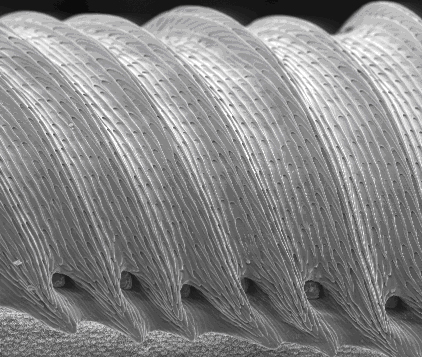PhD project: Michal R. Golos
This project investigates a particularly intriguing and poorly understood mechanism to make plant surfaces slippery for insects: ‘aquaplaning’ on wet trap rim of carnivorous Nepenthes pitcher plants. Most but not all plant surfaces are water-repellent. The highly wettable – ‘superhydrophilic’ – trapping surfaces of the pitcher plants that we study are a rare exception to this rule. When a water drop is carefully placed on the pitcher rim surface, it spreads immediately and forms a very thin, stable water film.
Water spreads against gravity on a piece of Nepenthes bicalcarata pitcher rim. (Video by Holger Bohn)
We want to know what makes these surfaces so extraordinarily wettable, and what causes the strongly directional water spreading behaviour. With the naked eye, we can already see a regular ridge-and-groove pattern on the surface. If we ‘zoom in’, using a powerful electron microscope, a more complex hierarchical topography of ridges, grooves and overhanging arches becomes visible.
 The pitcher rim surface features a complex hierarchical micro-topography of ridges, grooves and step-like overhanging arches.
The pitcher rim surface features a complex hierarchical micro-topography of ridges, grooves and step-like overhanging arches.
We want to understand how macroscopic and microscopic plant surface features impact (1) wettability and (2) water spreading on plant surfaces, and (3) how these topographical features interact with the underlying chemical make-up of the surface. To answer these questions we take advantage of the natural variation of surface features and wettability found in the species-rich genus Nepenthes, as well as employing artificial surfaces with precisely defined surface patterns to disentangle the effects of surface topography and chemistry. Together with David Labonte (Imperial College) and Finn Box (University of Manchester), we investigate how the shape, dimensions, spacing and tilting angle of surface features influence the overall wettability of the surface, and the direction and speed of water spreading across it. To shed light on the contribution of surface chemistry, we collaborate with Reinhard Jetter (UBC Vancouver), Sam Amsbury (University of Sheffield), the Wolfson Bioimaging Facility in Bristol, and Julian Moger‘s lab at the University of Exeter. By combining multiple different analytical and bioimaging approaches, we gradually unravel the detailed chemical composition of the wettable pitcher rim surface.
 A high-resolution electron microscope image reveals the layered structure of the wettable pitcher rim.
A high-resolution electron microscope image reveals the layered structure of the wettable pitcher rim.